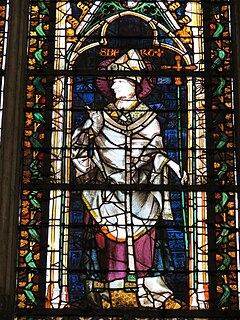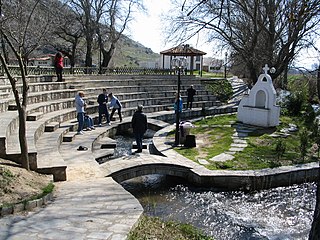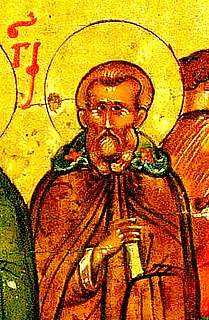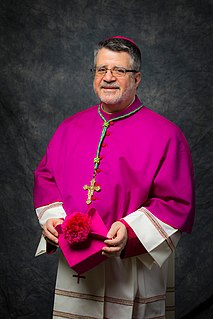Related Research Articles

The calendar of saints is the traditional Christian method of organizing a liturgical year by associating each day with one or more saints and referring to the day as the feast day or feast of said saint. The word "feast" in this context does not mean "a large meal, typically a celebratory one", but instead "an annual religious celebration, a day dedicated to a particular saint".

Aelred of Rievaulx ; also Ailred, Ælred, and Æthelred; was an English Cistercian monk, abbot of Rievaulx from 1147 until his death, and known as a writer. He is regarded by Anglicans and Catholics as a saint.

Marian hymns are Christian songs focused on the Virgin Mary. They are used in both devotional and liturgical services, particularly by the Roman Catholic, Eastern Orthodox, Anglican, and Lutheran churches. They are often used in the month of May devotions. Some have also been adopted as Christmas hymns. Marian hymns are not popular among Protestants, as many Protestants see Marian veneration as idolatry. However, the practice is very common among Christians of Catholic traditions, and a key component of the Eastern Orthodox liturgy. There are many more hymns to Mary within the Eastern Orthodox yearly cycle of liturgy than in Roman Catholic liturgy.

Saint Pantaleon, counted in the West among the late-medieval Fourteen Holy Helpers and in the East as one of the Holy Unmercenary Healers, was a martyr of Nicomedia in Bithynia during the Diocletianic Persecution of 305 AD.

Saint Fulgentius of Ruspe was bishop of the city of Ruspe, Roman province of Africa, North Africa, in modern day Tunisia, during the 5th and 6th century. He was also canonized as a Christian saint.

Ansbert, sometimes called Ansbert of Chaussy, was a Frankish monk, abbot and bishop of Rouen, today regarded as a saint in the Catholic Church.

Saint John's Abbey is a Benedictine monastery in Collegeville Township, Minnesota, United States, affiliated with the American-Cassinese Congregation. The abbey was established following the arrival in the area of monks from Saint Vincent Archabbey in Pennsylvania in 1856. Saint John's is one of the largest Benedictine abbeys in the Western Hemisphere, with 133 professed monks. The Right Reverend Fr. John Klassen, OSB, serves as the tenth abbot.

Lydia of Thyatira is a woman mentioned in the New Testament who is regarded as the first documented convert to Christianity in Europe. Several Christian denominations have designated her a saint.

Saint Euthymius the Great was an abbot in Palestine. He is venerated in both Roman Catholic and Eastern Orthodox Churches.

Saint Stephen the Sabaite, also known as Stephen the Hymnographer, was a Christian monk from Julis, a district of Gaza. He was a nephew of St. John of Damascus and spent a half-century in the monastery of Mar Saba. He is venerated as a saint in the Orthodox Church.

Saint Julia of Corsica, also known as Saint Julia of Carthage, and more rarely Saint Julia of Nonza, was a virgin martyr who is venerated as a Christian saint. The date of her death is most probably on or after AD 439. She and Saint Devota are the patron saints of Corsica in the Catholic Church. Saint Julia was declared a patroness of Corsica by the Church on August 5, 1809; Saint Devota, on March 14, 1820. Both were martyred in pre-Christian Corsica under Roman rule. Julia's feast day is May 23 in the Western liturgical calendar and July 16 in the East.
Felix of Bourges was a bishop of Bourges who later became recognized as a saint.
Peter of Atroa (773–837) was an abbot who was later canonized as a saint.
Eustace of Luxeuil, also known as Eustasius, was the second abbot of Luxeuil from 611. He succeeded his teacher Columbanus, to whom he had been a favorite disciple and monk. He had been the head of the monastic school.

Saint John Theristus was an Italian Byzantine monk, called Theristus or “Harvester”. Despite dying almost a century after the Great Schism of 1054, he is notably a saint in both the Catholic and Orthodox Church. The life of this monk is handed down by legends and popular beliefs.

Saint Peleus was an early Christian martyr. An Egyptian bishop, Peleus was one of four Christians who led Mass for the persecuted Christians condemned to work in the Palestinian quarries in the wake of the Diocletianic Persecution. When the Roman emperor Galerius learned of this, he had Peleus burned alive along with the other leaders, and the Christians dispersed to mines in Cyprus and Lebanon. He is venerated as a saint in the Roman Catholic Church and Orthodox Church.
Nilus of Palestine was an early Christian martyr. An Egyptian bishop, Nilus was one of four Christians who led Mass for the persecuted Christians condemned to work in the Palestinian quarries in the wake of the Diocletianic Persecution. When the Roman emperor Galerius learned of this, he had Nilus burned alive along with the other leaders, and the Christians dispersed to mines in Cyprus and Lebanon. He is venerated as a saint in the Roman Catholic Church and Orthodox Church.
Elias of Palestine was an early Christian martyr. A priest, Elias was one of four Christians who led Mass for the persecuted Christians condemned to work in the Palestinian quarries in the wake of the Diocletianic Persecution. When the Roman emperor Galerius learned of this, he had Elias burned alive along with the other leaders, and the Christians dispersed to mines in Cyprus and Lebanon. He is venerated as a saint in the Roman Catholic Church and Orthodox Church.
Patermutius was an early Christian martyr. A layman, Patermutius was one of four Christians who led Mass for the persecuted Christians condemned to work in the Palestinian quarries in the wake of the Diocletianic Persecution. When the Roman emperor Galerius learned of this, he had Patermutius burned alive along with the other leaders, and the Christians dispersed to mines in Cyprus and Lebanon. He is venerated as a saint in the Roman Catholic Church and Orthodox Church.

Elias RIchard Lorenzo OSB is an auxiliary bishop for the Roman Catholic Archdiocese of Newark, consecrated in 2020. He was previously the abbot president of the American-Cassinese Congregation of Benedictine monasteries. He was the third member of St. Mary's Abbey to hold this position and the first to become a bishop.
References
- 1 2 3 4 5 6 7 8 9 "Saint Who? Saint Demetrian". Magnificat . Magnificat USA. 18 (3): 121. May 2016.
- 1 2 3 4 Butler, Alban (1995) [1756]. Butler's Lives of the Saints. 11. Collegeville, MN: Liturgical Press. p. 47. ISBN 9780860122609.
- 1 2 "Saint Demetrian of Cyprus". CatholicSaints.info. 2013. Retrieved 12 May 2016.
- 1 2 3 4 "Saint Demetrian". Catholic.org. Catholic Online. 2016. Retrieved 7 May 2016.
- 1 2 3 Walsh, Michael J. (2007). A New Dictionary of Saints: East and West. Collegeville, MN: Liturgical Press. p. 150. ISBN 9780814631867.
- ↑ Pétridès, Sophrone (1908). "Chytri". The Catholic Encyclopedia. 3. New York: Robert Appleton Company. Retrieved 12 May 2016.